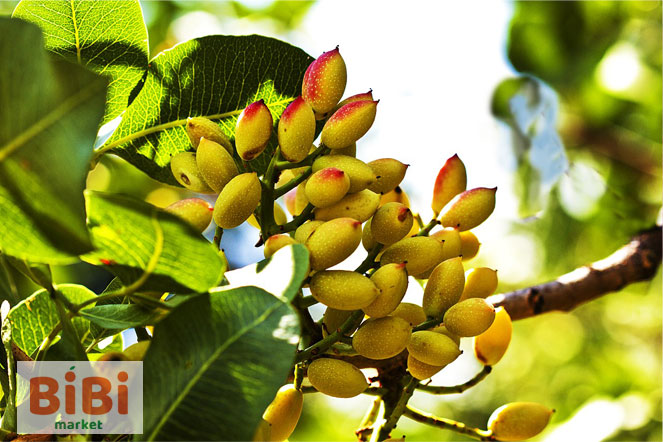Introduction
Pistachios are one of Iran’s most important agricultural products, often referred to as "green gold" due to their exquisite taste, high nutritional value, and economic significance. Iran is one of the largest producers and exporters of pistachios worldwide, and this crop has played a crucial role in the country’s agricultural economy for centuries.

History of Pistachios in Iran
Pistachios are native to the warm and arid regions of Iran and Central Asia, and they have been cultivated for thousands of years as a valuable food crop. Different regions of Iran, such as Kerman, Yazd, and Khorasan, are renowned for their pistachio production, and Iranian pistachios have long been recognized in global markets for their quality.
Types of Iranian Pistachios
Iranian pistachios are categorized into several key types, each with its own unique characteristics:
- Fandoghi Pistachio: This small, round pistachio is highly popular for its affordable price and excellent taste, making it a favorite for both domestic consumption and export.
- Kalleh Ghouchi Pistachio: Known for its large, round kernels, this variety is valued in international markets for its size and attractive appearance.
- Akbari Pistachio: One of the largest and most luxurious pistachio types, Akbari is favored for its large size and exceptional flavor.
- Ahmad Aghaei Pistachio: This elongated variety has a sweeter taste and is highly sought after for export purposes.
Nutritional Benefits of Pistachios
Pistachios are one of the most nutrient-dense nuts, rich in protein, healthy fats, fiber, vitamins, and minerals. Some of the key health benefits include:
- Improved Heart Health: The healthy fats in pistachios can help lower bad cholesterol and promote cardiovascular health.
- Boosting Immune System: Pistachios are rich in antioxidants and Vitamin E, which support immune function.
- Maintaining Healthy Skin and Hair: The vitamins and minerals like biotin and Vitamin B6 in pistachios help maintain skin and hair health.
- Weight Management: High fiber content in pistachios can promote satiety, helping with appetite control and weight management.
Economic Significance of Pistachios in Iran
Iran is one of the world's largest pistachio exporters, and this product remains one of the country’s key agricultural exports. The provinces of Kerman, Yazd, and Khorasan are the major pistachio-producing regions, exporting thousands of tons annually to countries worldwide. Pistachio exports contribute significantly to Iran’s economy, making it a vital strategic crop.
Challenges and Opportunities in Iran’s Pistachio Industry
Despite the industry’s successes, the pistachio sector in Iran faces challenges such as climate change, water shortages, and competition from other major producers like the U.S. On the other hand, advances in agricultural technologies and product processing offer opportunities to improve productivity and quality, creating new growth prospects for the industry.
Frequently Asked Questions about Pistachios
-
What are the nutritional benefits of pistachios?
Pistachios are rich in protein, fiber, healthy fats, and essential vitamins like B6 and E, along with minerals like magnesium and potassium. They help improve heart health, boost the immune system, and assist with weight management. -
Which regions in Iran produce the best pistachios?
The provinces of Kerman, Yazd, and Khorasan are known for producing some of the highest-quality pistachios in Iran. The city of Rafsanjan in Kerman is particularly famous for its pistachio production. -
What types of pistachios are grown in Iran?
The main types of pistachios grown in Iran are Fandoghi, Kalleh Ghouchi, Akbari, and Ahmad Aghaei, each offering distinct sizes, flavors, and export values. -
Can pistachios help with weight loss?
Yes, due to their high fiber and healthy fat content, pistachios can increase satiety, helping to control appetite and aid in weight management. However, portion control is essential. -
What is Iran’s role in the global pistachio market?
Iran is one of the world’s largest pistachio producers and exporters, with major buyers including China, India, and European countries. -
Are Iranian pistachios better than those from other countries?
Iranian pistachios are renowned for their distinct flavor and high quality, making them highly popular in global markets. While other countries like the U.S. also produce pistachios, Iranian varieties are considered among the best. -
How can you identify high-quality pistachios?
High-quality pistachios have uniform, light-colored shells and large, fresh-tasting kernels. The shells should not be overly open or closed, and the nuts should be free from any off-putting smell or taste. -
How should pistachios be stored?
To maintain freshness, store pistachios in a cool, dry place away from direct sunlight. For longer storage, they can be kept in the refrigerator or freezer. -
What’s the difference between raw and roasted pistachios?
Raw pistachios are consumed in their natural state and retain more of their nutritional value, while roasted pistachios have a more intense flavor, often enhanced with salt, though excessive salt intake can be harmful to some individuals. -
Are pistachios suitable for people with diabetes?
Yes, pistachios have a low glycemic index and are rich in healthy fats, which can help regulate blood sugar levels. Consuming them in moderation can be beneficial for people with diabetes.
Conclusion
Pistachios are not only a highly nutritious food but also an economically valuable commodity for Iran. The country’s pistachios hold a top-tier position in global markets due to their superior quality, and further investments in this industry can help boost economic growth and strengthen Iran’s international standing in the pistachio trade.

 English
English
 Persian
Persian 